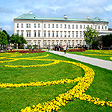ST
SEBASTIEN’S CEMETERY - SALZBURG
The Mozarts, Paracelsus and Wolf Dietrich Mausoleum
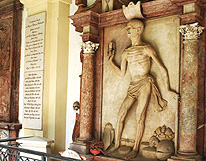 The
royals of the Imperial days of Austria are laid elsewhere in the crypts
of Vienna or Innsbruck, but
the resting place of the prominent
upper class and merchant families of old Salzburg is the fascinating
cemetery of St Sebastien’s Church with it Wolf Dietrich Mausoleum,
down a narrow medieval lane, the Linzergasse, not far from the birth
house of home town hero, Wolfgang Mozart. The original church of the
late Gothic age was built under the order of the Archbishop Leonhard
von Keutschach, from 1505 to 1512 (see Hohensalzburg Fortress), and dedicated
to St Sebastien, the patron saint of the sick, in memorium of the Black
Plague which swept the continent in the 1400s.
The
royals of the Imperial days of Austria are laid elsewhere in the crypts
of Vienna or Innsbruck, but
the resting place of the prominent
upper class and merchant families of old Salzburg is the fascinating
cemetery of St Sebastien’s Church with it Wolf Dietrich Mausoleum,
down a narrow medieval lane, the Linzergasse, not far from the birth
house of home town hero, Wolfgang Mozart. The original church of the
late Gothic age was built under the order of the Archbishop Leonhard
von Keutschach, from 1505 to 1512 (see Hohensalzburg Fortress), and dedicated
to St Sebastien, the patron saint of the sick, in memorium of the Black
Plague which swept the continent in the 1400s.
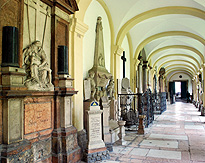 The
church was outside the city walls when first built, but over time surrounded
by it, now
rather hidden in a pedestrian section. The early church was rebuilt
in the grand Baroque style in 1750, with the addition of the onion
dome
to its tower, but suffered in a devastating fire which swept Salzburg
in 1818. The church has undergone modern restoration work returning
to some of its earlier glory, with its high altar decorated with
a beautiful
Madonna with Child by Hans Waldburger and Rococo entrance portal
by Josef Anton Pfaffinger, but what draws visitors are the noted graves
in the
colonnaded passage courtyard cemetery and mausoleum next to the church.
The
church was outside the city walls when first built, but over time surrounded
by it, now
rather hidden in a pedestrian section. The early church was rebuilt
in the grand Baroque style in 1750, with the addition of the onion
dome
to its tower, but suffered in a devastating fire which swept Salzburg
in 1818. The church has undergone modern restoration work returning
to some of its earlier glory, with its high altar decorated with
a beautiful
Madonna with Child by Hans Waldburger and Rococo entrance portal
by Josef Anton Pfaffinger, but what draws visitors are the noted graves
in the
colonnaded passage courtyard cemetery and mausoleum next to the church.
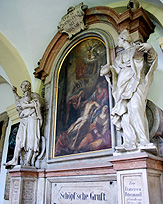 The
cemetery built in the style of an Italian “campo santi”,
that particular form of walled open mausoleum arcades of the dead. This
style of above ground cemetery was originally to protect the dead from
flood plains in the days of Rome and early middle ages, but took on an
artistic significance in the Renaissance and Baroque period with magnificent
examples like the original Campo Santo in Pisa and later renditions like
the Mirogoj Cemetery in Zagreb. The St Sebastien Mausoleum (St Sebastien
Friedhof) was commissioned by the Prince Bishop of Salzburg, Wolf Dietrich
von Raitenau, whose passion for building formed much the shape of Salzburg.
Dietrich had engaged Habsburg court architect Andrea Bertoleto (Bertoletti)
in 1589 for his ambitious projects and ordered the cemetery design in
1595 to replace the earlier church graveyard., but the designer himself
died before its completion in 1600.
The
cemetery built in the style of an Italian “campo santi”,
that particular form of walled open mausoleum arcades of the dead. This
style of above ground cemetery was originally to protect the dead from
flood plains in the days of Rome and early middle ages, but took on an
artistic significance in the Renaissance and Baroque period with magnificent
examples like the original Campo Santo in Pisa and later renditions like
the Mirogoj Cemetery in Zagreb. The St Sebastien Mausoleum (St Sebastien
Friedhof) was commissioned by the Prince Bishop of Salzburg, Wolf Dietrich
von Raitenau, whose passion for building formed much the shape of Salzburg.
Dietrich had engaged Habsburg court architect Andrea Bertoleto (Bertoletti)
in 1589 for his ambitious projects and ordered the cemetery design in
1595 to replace the earlier church graveyard., but the designer himself
died before its completion in 1600.
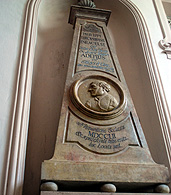 Some
rather eerie sculptures and reliefs line the arcades, a reminder of
the impermanence of life and the calling of the grim reaper on all.
The burials had been added over the centuries, generally with stone plaque
added to the family sites. Among the tombs of the passage is the famous
early physician-alchemist Philippus Theophrastus von Hohenheim called “Paracelsus” whose
uses of the techniques of alchemy in the formations of medicinal treatments
made him the father of pharmacology who died in 1541 (see Basel
Pharmacy Museum and Heidelberg Castle Aphothecary). His bones were moved from
an earlier grave and the effigy added with the 1752 reconstruction.
Some
rather eerie sculptures and reliefs line the arcades, a reminder of
the impermanence of life and the calling of the grim reaper on all.
The burials had been added over the centuries, generally with stone plaque
added to the family sites. Among the tombs of the passage is the famous
early physician-alchemist Philippus Theophrastus von Hohenheim called “Paracelsus” whose
uses of the techniques of alchemy in the formations of medicinal treatments
made him the father of pharmacology who died in 1541 (see Basel
Pharmacy Museum and Heidelberg Castle Aphothecary). His bones were moved from
an earlier grave and the effigy added with the 1752 reconstruction.
Mozart Graves
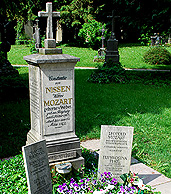 Perhaps
the biggest draw of the St Sebastien Cemetery are the headstones of
the Mozart family in the center of the grassy slightly overgrown courtyard.
Rather modest gold painted engraved markers, but the most known to tourist
to the city of Mozart (see Mozart Birthhouse and Museums). You won't find the famous composer’s grave here, famously dumped in an
unmarked pauper’s grave outside the walls of Vienna after dying
under notoriously mysterious circumstances (see Where Mozart
Died). In
a family cluster are the markers of the composer’s father Leopold
Mozart, wife Contanze (Constantia on the marker) along with her second
husband Geog Nikolas von Nissen, whom she married after returning to
Salzburg (see Tomaselli’s
Café). Also in the group is Constanze’s
aunt, Genovefa von Weber, noted as the mother of the composer Carl Maria
von Weber.
Perhaps
the biggest draw of the St Sebastien Cemetery are the headstones of
the Mozart family in the center of the grassy slightly overgrown courtyard.
Rather modest gold painted engraved markers, but the most known to tourist
to the city of Mozart (see Mozart Birthhouse and Museums). You won't find the famous composer’s grave here, famously dumped in an
unmarked pauper’s grave outside the walls of Vienna after dying
under notoriously mysterious circumstances (see Where Mozart
Died). In
a family cluster are the markers of the composer’s father Leopold
Mozart, wife Contanze (Constantia on the marker) along with her second
husband Geog Nikolas von Nissen, whom she married after returning to
Salzburg (see Tomaselli’s
Café). Also in the group is Constanze’s
aunt, Genovefa von Weber, noted as the mother of the composer Carl Maria
von Weber.
Enscriptions:
Constantia von Nissen
Wife of Mozart
Born von Weber in Troyburg,
January 1763
Died Here 6 May 1842
Leopold Mozart
High Court Vice Choral Master
born in Augsburg Nov 1719
Died, 28 May 1787
Wolf Dietrich Mausoleum
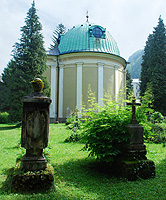 Most
prominent in the center of the courtyard is the tomb for the Prince
Archbishop Wolf Dietrich himself, who died in an epileptic seizure while
under arrest and imprisoned in the Hohensalzburg Castle in 1617. His
building plans had come to stop in a dispute with the King of Bavaria
in a dispute over the control of salt mining rights which built the city’s
wealth. The cylindrical tomb the Gabriel Chapel which takes its name
from the motifs of the archangel trumpeting the end of the world was
designed by Elia Castello, with ornate marble altar and statues of the
archangels added during the Baroque expansion of the church. The designer-architect
Castello who presumably took over from Bertoletto also has a burial monument
and relief effigy in the arcades.
Most
prominent in the center of the courtyard is the tomb for the Prince
Archbishop Wolf Dietrich himself, who died in an epileptic seizure while
under arrest and imprisoned in the Hohensalzburg Castle in 1617. His
building plans had come to stop in a dispute with the King of Bavaria
in a dispute over the control of salt mining rights which built the city’s
wealth. The cylindrical tomb the Gabriel Chapel which takes its name
from the motifs of the archangel trumpeting the end of the world was
designed by Elia Castello, with ornate marble altar and statues of the
archangels added during the Baroque expansion of the church. The designer-architect
Castello who presumably took over from Bertoletto also has a burial monument
and relief effigy in the arcades.
Visiting the St Sebastien Cemetery and Wolf Dietrich Mausoleum
The cemetery is open from 9am to 7pm April to October and 9am to 4pm November to March. Admission is free of charge. In the winter months the entrance is only through the Feuerwache Bruderhof passage. There are a couple of small historic hotels nearby, dating back sveral hundred years, though not the eponymous and rather opportunistic Wolf Dietrich Hotel which stands visible above the walls of the cemetery. © Bargain Travel Europe
Find best hotel and travel deals in Salzburg on TripAdvisor
Web Info
Salzburg
Tourism
These articles are copyrighted
and the sole property of Bargain Travel Europe and WLPV, LLC. and
may not be copied or reprinted without permission.
SEE ALSO:
HELLBRUNN PALACE TRICK FOUNTAINS
SACHER TORTE AND THE CAFÉ LIFE
SALZBURG ADVENT CHRISTMAS MARKETS
BEER & BREWERY TOURING SALZBURG

